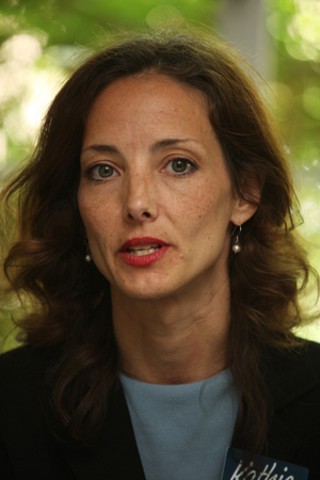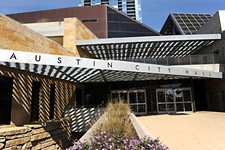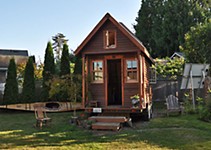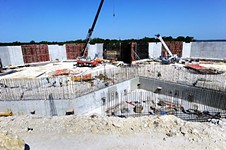'Completing Communities'
A conversation with Kathie Tovo
by Wells Dunbar, Fri., June 3, 2011

Austin Chronicle: You've campaigned on promoting affordability and keeping neighborhood schools open – two issues that go hand in hand. As a council member, what would you do specifically to promote both?
Kathie Tovo: Educational impact statements – that will be one tool to measure how development is going to impact schools. It was a recommendation on both the Families and Children Task Force and the [Austin ISD Community] Committee, because I was on both, and I made sure it went to both places. And then it became a priority of the Joint Subcommittee [of AISD, Austin, and Travis County], because a small core of us talked to our council members, who were supportive, and made sure that it became a priority of the Joint Subcommittee, and then it wound to the Planning Commission. It's basically a tool that's going to help decision-makers on the board and commissions, and then council, ultimately, think through how a particular development or redevelopment might impact schools in the area.
The next part of that, now that we've got that in place, is really to use it, use it to help guide our decision-making. I hope that the discussions around it, as they prepare it, will really help inform people about how these things are connected. Just for an example, we had a case coming before the Planning Commission right before I stepped off – I forget what the exact zoning change was, I think they were changing from [commercial services] to multifamily. It's a big project down on South Lamar; some of it needed to be rezoned, some didn't, but it was a pretty significant shift. And it's a perfect time to talk about: "Well, this is going to be a lot of new apartments in this area – what are they gonna look like? Are they going to be two bedrooms, three bedrooms?" Because that will make a big difference in terms of the impact on the schools around there. It doesn't mean it should change course one way or another, it's more of an early heads-up to the schools in the area that they need to prepare for an influx of, for instance, 100 kids. In this case, unfortunately, for that area, it sounds like they're looking at kinda one and two bedrooms, so it's probably not likely to include many families.
AC: That was pretty recently passed at the council, right?
KT: It's been years in the works [laughs]. I think I was on those committees back in '08. It just took a very long time to see that through to fruition. It's not a very complicated document, but it took a good, long time.
AC: What do you attribute that to?
KT: Sometimes the wheels turn very slowly at the city. It's a frustration as a community volunteer to see it moving so slowly, because I think there have been some decisions that have come and gone where that would've been useful information to have.
AC: It almost sounds like you're implying there might have been some resistance on the part of people at the city to pushing it forward.
KT: I never understood why it was moving so slowly. Another community volunteer and I worked on it, did a lot of the work, and then the staff, of course, did their bit. It probably was a staff time-management issue. They've got a lot on their plate, and new initiatives, and posting issues might have been part of the time lag.
In the end, I heard from one developer. We talked about it, I think, for the last time at the Neighborhood Planning Subcommittee, and he called me the next day – this is Ron Thrower – and he said, "When I first heard about this, I was kinda irked, because this was gonna be a new requirement for applicants, but I think this is really important." I don't want to speak for him, but I wrote his words down somewhere. He said something along the lines of "This is gonna be one of the most important things we've done recently in terms of thinking through our schools." Anyway, I don't think it met with resistance in the community – as I said, the one person I heard from in the development community was supportive of it.
Anyway, that's one specific idea. Another is looking for ways to partner in the use of resources, whether that's buildings or playground facilities – I think there are opportunities for the city and the school district to really share responsibility for managing some of those spaces.
One of the other priorities we put before the Joint Subcommittee. ... They have been largely – how do I characterize it? – they haven't been the most active group. They would meet quarterly and they would have presentations that were of interest, and then they would go back to their respective bodies. And so some of the recommendations that came out of those two committees I mentioned – the Families and Children [Task Force] and AISD, and again, we made sure there was consistency because we wanted them to be in synch – they recommended: "Hey, that's our opportunity for collaboration. Let's make that a more active group." Maybe if they identified a few key issues that they're gonna focus on, that would kinda propel them toward action rather than just passively listening to presentations. You could really get them focused. And that has worked – they've actually taken up good stuff like student stability, keeping kids in their home schools, working together to make that happen, because there's such a high mobility rate within AISD and so much of that has to do with housing. That was a recommendation that came out of the Families and Children Task Force, and I haven't been involved with that initiative, but they made some good strides.
Anyway, back to joint use – that was another thing that we wanted that committee to focus on because there's just some simple things that can happen. For example, when I was working with Becker Elementary, the Dougherty Arts Center had a need for space. Becker Elementary was getting a lot of flak from the school district for being under-enrolled and not using its space as efficiently as possible. Well, there might have been an opportunity to partner with the Dougherty Arts Center, get them some space for cost, and try to bring some revenue into that school. But there was no mechanism for making that happen. From what I understand, and I don't understand a lot about it, it tends to be a sort of campus-by-campus decision rather than a policy across the board. This is anecdotal, but I was talking with someone at the Parks department; they had to close one of their rec centers and were trying to work with some of the different schools in the area to relocate programs, and they were running into the same challenges. There was no real policy for working together. I think we have some missed opportunities there because of a lack of clarity and a lack of a history of partnership. There are some places that work great, like the Pickle Center and St. John. [Editor's note: The J.J. Pickle Elementary School and St. John Branch of the Austin Public Library are combined under one roof.] I think there are some joint-use facilities that work really well as new facilities. It's a little easier to do those kind of partnerships from the ground up. I think we have some opportunities to look at some of the schools where there might be a community need that could be met in the school facility and serve a dual purpose of using that space more efficiently, and maybe reducing the cost per student.
AC: Speaking of AISD, that's something you've spent a fair amount of time addressing. Recently AISD announced they'd be putting their Sixth Street headquarters up for sale. I'm curious what you think of that, but also more holistically how the district is doing right now. I understand there are some rumblings that the superintendent is taking another look at the Facility Master Plan.
KT: I think we've got a very strong and creative superintendent. I have a lot of faith. I haven't worked with her personally, but I've been watching her in action and I think she's very community-oriented and really concerned about the community's input, which is a good direction to be going in. And I applaud that decision. I think it's gutsy to put their administrative buildings up for sale, and [it's] something that's really responsive to the community. Because when we started the Facility Task Force process, we went out to the community with a survey, and one of the things more than just a couple responded with was, "Hey, if you're looking at facilities, you ought to think about selling that building and moving to a different space." And you know from following the AISD task force, administrative facilities came in very, very late in the process. To my frustration, and to the frustration of others, those were never discussed early on, despite the fact that some of the community wanted us to talk about those first. So I think it's a really good step. I think they could find some space somewhere else that might be better-suited to their needs, and ... cheaper. It's not a long-term strategy – again, I wasn't involved in a big, thorough discussion about this, but I have heard some comments about the fact it might be more productive to have more of their staff centralized or some of the staff that is centralized out in the campuses. So I think it will cause a shifting, a rethinking of who needs to work together, who needs to work on campuses, and so I think that all seems like a very productive dialogue.
AC: We're seeing the beginning stages of this collaboration between AISD and the council. So as a council member, is there anything in that relationship that's missing right now you think you could add?
KT: Back in 2006, when the district was proposing closing the two neighborhood schools, Oak Springs and Becker, there was a lot of call in the community for more collaboration. I think there was a lot of attention among the City Council, a few of them signed on to a letter to the district to say, "Hey, we need to keep our schools in the central city open." So for a very short time after that crisis had passed, I think the issue had the attention of council – and then, here we are again. One thing that I will bring to that council is that this is gonna be a primary priority, I'm not gonna lose focus on that. Because we just needed to figure out if there are strategies, if there are really proactive steps we can take to keep the neighborhood schools open, we need to do it now because it's going to continuously be an issue for some of our central-city schools.
Housing is certainly a challenge: Looking at ways to promote affordable housing and family-sized affordable housing in some of the areas where our schools are under-enrolled is important. Considering if there are ways to partner on services that might go into some of those facilities that are, at the moment, underutilized. In looking around the country, there are some great best practices. One of the things that I did a few presentations on for a Planning Commission subcommittee was this idea of joint use. There's some examples around the country of best practices where cities and school districts have partnered together in creating schools that have a community health clinic in them, or have shared library space, so the school library also becomes a public library. ... Looking around the country, there's some really great examples of that – even some examples of a bank located in an under-enrolled school. Of course, there are many, many challenges to making sure the security works well; there are many challenges to be addressed in those kinds of partnerships. But I don't think they're insurmountable, and I think we can learn a lot from looking at ways other municipalities have done it.
Again, I think that is something that I bring to council that has not been a primary focus. Certainly Council Member Morrison has been active in moving forward some of the initiatives of the Joint Subcommittee, and some of the progress we've seen has happened as a result of that. And so I think its great that the council is paying attention to it again, although I don't know what the status is of some [of the initiatives] – staff was sent off to work together and look at ways they might work together; I don't know where they are with that. But I think it's a great stride. I think that we do need to get back to some of the Families and Children [Task Force] recommendations and see what work needs to be done next, because we know that the trend of families with children moving out of the central city has continued.
One of the recommendations we made that has not been followed was that AISD and the city sit down and come up with a plan just aimed at trying to address neighborhood schools and their declining enrollment. So I think that's something that good minds could be brought in to talk about. Some of these things will help – looking at the educational impact statements, being aware of how land-use decisions will impact schools, especially when those decisions will result in a loss of what was family housing. Educating the development community about ways of building for families with kids, I think, is something I think hasn't happened very much in this market. Places like Portland [Ore.] have had a courtyard-design competition, where they aired best practices for creating housing for families and kids – balancing needs for storage with communal spaces versus private spaces – what are some design elements that really create family-friendly housing?
AC: How do you incentivize that sort of construction? It sounds like the educational impact statements are a good tool for monitoring changes and seeing where there's work to be done, but maybe not a proactive tool.
KT: Absolutely. That's exactly right. We had proposed that maybe there be a design competition, and I'd still like to see that happen. Council Member [Jennifer] Kim had suggested maybe the city could do a pilot project – that requires some thinking about how that would happen, in terms of city funding. But some of it really is about education. When I talk with developers in the community, they've said, "In this market" – and this was when this was a healthier real estate market – "lenders don't want to lend for an untested model." And multifamily housing for families with children in the central city is kind of an untested model, here in Austin. It's a financing challenge. So, how we do it, how we incentive that, is something I hope will be addressed in the Comprehensive Plan, whether that gets done with density bonuses or relaxation of some other standards. I think that's something that I know, that particular point, is now in the strategic vision [of the Comprehensive Plan], so I hope there will be a community discussion around how to achieve that. I believe there are some cites where they've made certain things requirements, but I think incentives and encouragement and providing education about how easy it is to do in many cases. And when we look at public spaces and parks, many of the things that make those spaces more appealing to families and kids make them more user-friendly for individuals across our community. When you're thinking about curb cuts, for example – that helps somebody pushing a stroller get across a busy street, but it also helps somebody in a wheelchair get to where they're going more safely. Many of the strategies for designing our communities with an eye toward the needs of families and children really make the spaces work better for all Austinites.
AC: One more fundamental criticism that's been leveled at your campaign is that your goal of "complete communities" – the live-work-play ideal with affordable family housing – may be at odds with some policies supported by some of the neighborhood associations you've been affiliated with. The Austin Neighborhoods Council, for instance, seemed supportive of the McMansion ordinance, which some people argue has facilitated sprawl by preventing the sort of home expansions that would keep growing families in the city.
KT: I guess I just don't buy that argument, especially about McMansion. Because, for one thing, a lot of people were really concerned about the McMansion ordinance; it was going to kill the building industry in Austin. It really hasn't, and a lot of the McMansions weren't adding density to our neighborhoods because they were typically being occupied by a couple of people. I think that you can add on a considerable amount to your house and not be a McMansion. Absolutely, we want to be sure our land development code allows for people living in small bungalows that might have accommodated families 40 years ago when we want them to be able to add on in ways that are appropriate. I think there's a lot of room for doing that without running up against the McMansion standards. And as you look at older neighborhoods, people are adding on. And in looking at our Families and Children [Task Force] research – families with kids will live in smaller spaces, including multifamily residences, if the spaces are well-designed. I'm married to an architect, and he's done some additions to older houses for families that wanted to stay in the central city but the house was really too small for their modern standards.
[Editor's note: In response to this question, Tovo later added the following to her answer via email:
KT: This criticism has little grounding and shows a lack of understanding of the research in this area or the work that has been done by groups like the city's own Families and Children Task Force. Neighborhood associations tended to be big supporters of many of the amenities that enhance the quality of life for families across the life span: parks, open spaces, sidewalks, and safe pedestrian and bike routes.
The reasons families with children have been leaving the central city are complex. But clearly major factors are the need for family-friendly housing (at all income levels), good neighborhood schools, and the amenities that attract and keep families in our central city. Suggesting that unregulated development will somehow lead developers to create more affordable housing or more family friendly housing is incorrect.
(And for the record – the trend of families leaving the central city pre-exists the McMansion Ordinance.)]
AC: There's also the question of multifamily housing – if we're going to attract more young families into the central city, we'll have to have a good mix of multifamily options. The charge has been made there, too, that some neighborhoods haven't accepted sufficient multifamily zoning or upgrading their [vertical mixed use] standards, for instance.
KT: The neighborhoods I'm aware of with neighborhood plans, most of them do identify areas where they want to see that kind of multifamily housing. Some of the neighborhoods are really content to have infill from secondary apartments, and I think that's one way to continue to densify our areas. I'm not sure there's really much conflict.
AC: And regarding the opt-in to VMU zoning, do you think their established neighborhoods did their fair share?
KT: You know, I wasn't on the Planning Commission when most of those went through, but the neighborhoods I'm familiar with – my neighborhood planning team, Bouldin Creek – I think almost everything that could be VMU ended up being VMU, and I'm not sure that any properties were opted out. I was talking to some folks from Chestnut; they were very excited about the prospect of having more density in their transit-oriented development.
One of the real challenges has been the issue of affordability and the cost of housing. This idea – that if developers can just come in and build their project with a rezoning, it's automatically gonna be affordable if they can do more units – isn't necessarily true. If we're saying, "We'll allow this up-zoning on the assumption that some of it will cost less" – I don't know if that always works out that way. I do think that's why when we have density bonus programs, we ought to use them. We ought to make sure when there are increases in entitlements, if it's appropriate, to ask that developer, or require that developer if they're going through a density bonus program, to provide some kind of community benefit. And if what we've identified as a major community need is affordable housing, let's strive to get some on-site affordable housing there.
AC: Randi Shade's promised to draw stark distinctions between you and herself in the campaign coming up. So I would just like to hear how you would describe those distinctions between the two of you.
KT: I heard some of the distinctions she drew yesterday [May 19, at Shade's City Hall announcement that she would stay in the race], and I think most of them were frankly inaccurate. ... For one thing, my idea of complete communities definitely includes having safe and secure neighborhoods, and so a big part of that is making sure we have police and EMS and firefighters out on the streets. I certainly don't support making cuts to those.
But in terms of differences, I think if you look at my supporter base, you get a sense of the kinds of involvements I've had and the kinds of people who are supporting me. And they are grassroots organizations, environmentalists, a healthy mix of architects, some engineers. I've got a really broad base of support – while there certainly are members of the development community on there, that's not my primary backing here, and I think she does have quite a bit of development support behind her. I consider myself to be very forward-looking in terms of planning issues and very supportive of good development in the right places and development that really works well for our community. I think I've thought more broadly about these issues. To me, it's not just about density. I've had an opportunity in serving on these committees, but also serving on the Planning Commission, thinking really about how we want that. Just talking about density doesn't get us there. Just talking about tall buildings doesn't get us there; it's really about the kind of buildings we're developing and what kind of services they have near them. I really believe that I think more broadly about land-use issues and how our community needs can be met.
I'm an independent thinker. I don't have ties to the development community that will prevent me from standing up against projects that I don't think are good. I am certainly sensitive to neighborhood issues, but I have voted against neighborhoods when I thought that a proposed change was good for our community. Sometimes people talk about my record as – well, I think in fact she did yesterday – that I don't support mixed use. Well that's completely false. I supported most of the things that came through the Planning Commission. I'm very supportive of mixed-use projects and tall buildings in areas we've said as a community we want to see them.
AC: You alluded a minute ago to projects where there's debate over whether they should go forward. They don't get any bigger than Water Treatment Plant 4, which has been another point Shade has raised in painting a difference between your candidacies. You told us in the past you wouldn't have voted to approve it, but you planned on protecting the city's investment in the plant. So, honestly, I'd like a yes or no answer if you plan on attempting to stop construction of the plant, if elected.
KT: Well, we have talked about this issue a lot, probably for the past eight weeks, so I thought it was interesting that she said the run-off was going to be a useful and productive time to talk about the issues, because that's really what we have been doing.
I did absolutely say, and I stand by it, had I been on council I wouldn't have voted for it. To me, it's a different question now because the project is under construction and there has been a substantial investment of taxpayer dollars. So any decision would have to be considered in light of the financial implications, the economic implications – I don't have access to all of that information at this point. My priorities are going to make sure we have an ample and secure water supply, and that any decisions protect that investment. And so one action that I do think is prudent, and I will take on council, is to look at that project and see if there are ways we can cut costs. Can any of it be done more cheaply, or should the city proceed in a way that can save, can economize?
AC: So are you hesitant to give a yes or no answer because you don't feel you have all the information you need?
KT: Yeah, I think that's accurate. It's not a yes or no. It's easy to look back on a decision that happened before. Now that it is, as I said, a substantial investment that's already been made, and construction's under way – there will be economic implications, and there will be legal implications.
AC: I don't even know what it would look like to stop it at this point, since the money's allocated and the approval's been granted.
KT: And they've broken ground. It would have to be a much fuller consideration of all of the impact. And I spoke with some folks this morning who talked about another type of impact, and that is on the contractors involved in the project, many of whom are small businesses. There are many, many issues there that would need to be considered.
But our goal should always be to work to save money, especially right now. It has been really clear to me on the campaign trail that affordability is just the number one issue for everybody I talk to. I was standing outside a polling place during early voting, and a woman stopped and talked to me, then she went in and voted and came back out and talked some more, then went home to her house and came back – she kinda laid out her everyday costs of living for me, and she's living on a very fixed income. She said [of] the increases in utility charges, the increase in water charges, "These are going to hit me hard because I'm struggling; I'm hardly staying in my house right now." So I think we need to work as a city toward really figuring out how, during this very difficult economic time, how we can keep costs from continuing to rise unnecessarily.
AC: Well that's an interesting point you raise, since the impact of WTP4 on the water rates has been widely debated. But on electricity rates, this would be the first rate increase in well over a decade. So is that merited? It's one thing to hear you talk about the increase in utility rates, but we've also heard the utility itself is facing uncertainty going forward, trying to promote these twin missions of conservation and selling energy.
KT: These are business models we really have to evaluate because we want people to conserve water, but on the other hand, the business model really relies on selling more water. So I think that is a challenge the city has really got to tackle head-on – whether that means putting together a blue-ribbon committee of [chief financial officers], private business, and looking at some of the financial decisions that have been reached, and try[ing] to figure out a more sustainable model going forward. But we don't want those things to be in competition; we want to be able to realize our water conservation goals because it's such a scarce resource, and ultimately, we want to make sure that we're protecting those goals.
With regards to Austin Energy, I've heard some ideas raised to make that business model more sustainable, looking at other kinds of revenue-generating opportunities, and I think that is a much fuller discussion. But as part of the rate case, I hope the city will take an active role in making sure that the public is really informed about past financial decisions and why some of these rate increases are necessary. Because I think we all need to understand why those costs are going up, and we've got to try and minimize the increase on that as the rate case goes forward and make sure that any increases are justified and they're spread among all users and don't impact one part of the community more heavily than another.
[Editor's note: The remaining portion of this interview was conducted over email.]
AC: Many of the issues you've raised or alluded to in your campaign aren't directly tied to Shade – council action extending wastewater service to the Formula One site, or approval of the Park Planned Unit Development, either passed unanimously or by a 6-1 majority.
KT: My campaign is about changing the direction at City Hall. Shade has figured prominently in many of the decisions my campaign has brought to light, whether it is through her close association with the Formula One law firm that is one of her largest fundraisers, or rising utility costs because of poor infrastructure decisions, or presenting herself as the "swing vote" who always seems to come down on the same side of development.
Furthermore, the emails (both in public and later private emails in which she conducted city business) and her own statements reveal that Shade presents herself as the architect of many of these decisions. Lopsided votes don't necessarily reflect healthy debate or good decisions.
We need leaders who have ideas and strategies to articulate new visions for the future and will then do the hard work once elected to move us further down the path toward a community that ... can work better for all Austinites. We need real leadership on these and other issues and my past work on and commitment to affordability, schools, and designing communities that meet the needs of families and individuals at all stages of life sets me apart from my opponent.
AC: On Formula One, you've said council "may give $4 million a year to subsidize a race track." What is your understanding on how and when this transaction will take place?
KT: Council Member [Laura] Morrison commented from the dais last Fall that the proposal would come before Council "later this year"; a Formula One timeline from the Texas Comptroller's office notes June 2011 as the time frame for the city and state to "enter into an Agreement." Given the situation at the Legislature, however, I don't know if the state's timeline will be adjusted.
Along the campaign trail I've had the opportunity to speak with many Austinites about this issue, and most object to the idea that the city might provide an incentive to the Formula One organizers. In fact, on last year's city budget survey more than 1,600 participants objected to the idea of city funding for Formula One – and that question drew more votes than any other citizen suggestion.
Like others, I am not arguing about whether Formula One should come to Austin – I just don't believe we should subsidize that private enterprise with our very scarce public dollars. We have too many other needs in our community, from more sidewalks in most of our neighborhoods to increased police patrols in other areas.
The city's most recent budget memo includes major cuts to programs like the supervised playground program which serves hundreds of Austin families – including those who cannot afford expensive summer camps and need safe and affordable options for their children when school is recessed. Again, it's a question of priorities and how we spend our limited public money; I'd rather see our limited public dollars go toward investing in programs that make everyday life better and easier for Austin families than providing incentives to a private enterprise that intends to locate here, with or without incentives.
AC: You also charge our current council is "more concerned with making big development deals than maintaining the quality of life and affordability for people who live here." What specific development deals are you referencing?
KT: Two big development deals that stand out as an example of instances where the City Council hasn't listened carefully enough to the people on Austin: The council voted to provide a $65 million incentive to the Domain – over the objections of many members of the public who argued that the benefit of this project to the community didn't outweigh the very substantial costs to the city, not to mention the impact on existing local businesses. (I realize this pre-dates Randi's time on Council, but it is certainly one of the biggest development deals in recent years.)
The Park PUD is a different situation, but I regard it as another example where the council, and my opponent, sided with the developer over the community. And in doing so, the council overruled not just the Bouldin Creek Neighborhood Plan but also a unanimous decision from the Planning Commission and the city staff. The Council needs to stop making special deals that override our community visions and processes.
I'd cite the Water Treatment Plant 4 as another example.
Look at the forces rallying against my campaign – the Austin Homebuilders Association, the Real Estate Council of Austin, and the developers and lobbyists who are the biggest fundraisers for Randi Shade – and you see clearly that big development has much invested in our Place 3 incumbent.
AC: What is the council's role in regards to economic development? Should they be offering incentives for companies like Facebook and Hanger to locate here? And what effect do you think these programs have had on Austin's comparatively positive response to the national recession?
KT: The council should spend our public money wisely and should offer incentives to private businesses when appropriate. Unlike my opponent, who said in an email that she didn't regard the $500,000 for Hanger as an "incentive," I believe the council should take a careful and informed look before granting hard-earned dollars to private firms. As a council member, I will scrutinize economic development packages and will support them when a cost/benefit analysis demonstrates that the community benefits will substantially outweigh costs, when the business meets the city's goals/priorities, and when the company will be creating good – i.e., not temporary – new jobs that pay livable wages. And we need to always have these conversations about potential incentives within a full public discussion and debate. Certainly the city's success in attracting companies like Facebook and Hanger has been part of why Austin has been less negatively impacted by the recession.
Got something to say on the subject? Send a letter to the editor.










